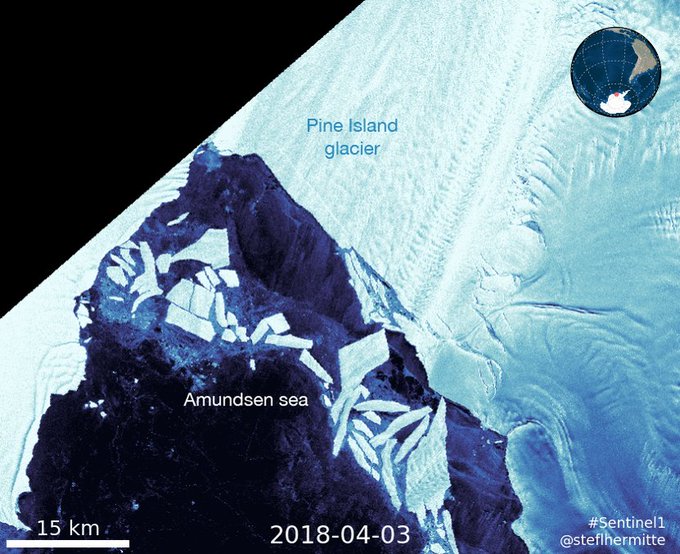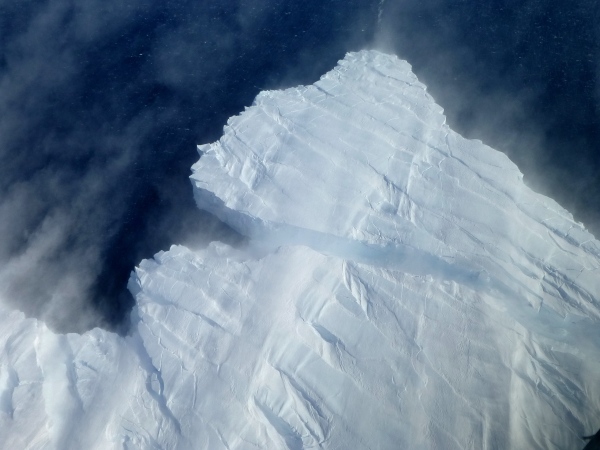The Increasingly Fragile Pine Island Glacier Just Calved Again
9
April, 2018
The
point where the Pine Island and Thwaites glaciers meet the sea serve
as a back-stop restraining most of the great ice flows of West
Antarctica. If those backstops were to fail, ocean water would flood
inland along a reverse slope and generate a massive and swift
out-rush of ice that would ultimately raise the world’s oceans by
about 3 meters. And, lately, the
evidence is mounting that the backstops are failing.
At Thwaites,
just south of the neighboring Pine
Island Glacier (PIG),
recent research found that the ocean was flooding inland beneath that
enormous ice sheet at a
rate of up to 400 meters per year.
But to the north, there is indication of trouble at the ice surface.
Back
to Back Calving Events
Just
last September, a
massive 100 square mile ice berg calved off the Pine Island Glacier.
The event was significant in that it marked the first major retreat
of the glacial front in the face of an advancing ocean. Pine Island
had already sped up. But the calving face withdrawal inland appeared
to mark a new phase for
the large glacier.
Another calving event at Pine Island Glacier as seen by @Copernicus #sentinel1 as the rift as the SW ice shelf released multiple small icebergs. It will be interesting how the rest of this high damage area will react.
(Sentinel
1 satellite observations show a rapidly moving Pine Island Glacier
calving off another large ice berg. Meanwhile, considerable damage
appears to have been done to the glacial front.)
Now,
just 7 months later, PIG
is calving again.
A large, approximately 6 kilometer long, 1 kilometer wide, chunk
appears to have broken off into the Southern Ocean and shattered.
Meanwhile, to the north and south along the glacial front, rifts
appear to have formed.
This
recent calving event is significant for a number of reasons. The
first is that it’s happening just months after a recent large
break-off during 2017. Other
recent calving events at Pine Island occurred during 2001, 2007, and
2013.
The present 2017-2018 events are back-to-back. The second reason is
that the splintering appears to indicate a more fragile ice face. An
impression reinforced by the concordant formation of rifts spreading
away from the calving zone. The third is that the satellite imagery
suggests Pine Island Glacier is moving quite rapidly (Recently, this
rate of motion has been 1-2 km per year.
However, it’s reasonable to question whether the glacier is
continuing to speed up).
Conditions
in Context
Present
global warming due to fossil fuel burning has now forced the world
into a range of temperatures between
1.0 and 1.21 degrees Celsius above 1880s averages.
This boundary is similar to that of the lower range of
the Eemian 120,000
years ago when oceans where 10-20 feet higher than they are today.
(The
tall ice cliffs composing the Pine Island Glacial front have become
increasingly fragile and fast moving as they enter the warming
Southern Ocean and as that warming water continues to invade inland.
Image source: Commons, Pine
Island Glacier Calving Front,
NASA.)
Under
present greenhouse gas forcing and planned emissions, additional
warming is in store. Climate models produced by Dr. Michael E
Mann indicate
that we are likely to hit the 1.5 C global temperature boundary some
time between 2027 and 2031 on
the current emissions pathway. This predicted warming is significant
because analysis of past climates appears to indicate a risk of more
rapid rates of sea level rise when global temperatures rise to a
range between 1.5 to 2.5 C above past base line averages
(see meltwater
pulse 1 A).
Since
the 1990s, the
global rate of sea level rise has proceeded at roughly 3.3 mm per
yearwith
an apparent acceleration to around 3.6
to 4.1 mm per year during the 2010 to present time period.
Given observed ice sheet instability in West Antarctica, in East
Antartica, and in Greenland, there is a serious risk that this rate
of rise will continue to accelerate over the coming years and
decades.
The key question of concern is how much and how soon.


No comments:
Post a Comment
Note: only a member of this blog may post a comment.